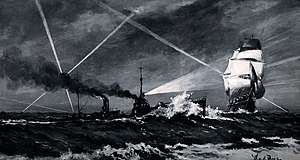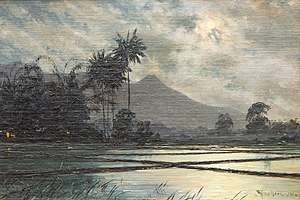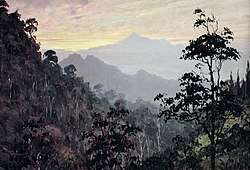Willem Jan Pieter van der Does
Willem Jan Pieter Van Der Does (Rotterdam, 20 April 1889 – Zeist, 3 February 1966) was a Dutch painter associated with the East Indies impressionist movement
Willem Jan Pieter van der Does | |
|---|---|
 Willem van der Does in his studio | |
| Born | Willem Jan Pieter van der Does 20 April 1889 |
| Died | 3 February 1966 (aged 76) |
| Nationality | Dutch |
| Education | Rotterdam academy of art |
| Known for | painting, illustration, watercolour |
Notable work | Zeilen door de grote storm |
| Movement | Impressionism |
Biography
Willem Jan Pieter van der Does was an internationally known Dutch painter, illustrator, draftsman, and water colorist in the early and mid 20th century. He is one of the founding fathers of the Dutch Indies impressionist movement.
Willem van der Does was born on 20 April 1889 in Rotterdam, Netherlands. He was the son of an expat (probably a sea commander) working in the (former) Dutch East Indies. Since his childhood, Willem van der Does had always been taught to become an artist by his family, in his youthful years he studied in de Rotterdam Academie van Kunst and then continued his study privately. He came to the Dutch East Indies in the year c.1918, and growing up there until he became a civil servant to survey the country. In this function he traveled all over the archipelago such as Surabaya, Batavia, Medan, Malang and Bandung.
He participated in several group and solo exhibition in the Netherlands and Indonesia. He was also the first ever known Dutchmen to have traveled to Antarctica. During his travel to Antarctica in 1923-1924, he made around 144 sketches for his book "Storm, Ijs, en Walvisschen" which describes his expedition and journey in exploring Antartica with his fellow crew member.[1][2]
In 1936 Willem van der Does participate in the 1936 Olympics event in Berlin, Germany. In this event he submitted a painting that he had created in the Dutch Indies titled "Towards the Unknown" (the subject are two explorer struggling to fight the heavy stormy breeze cold in Antarctica), the painting was exhibited in the Kaiserdamm hall, along with other submitted paintings.[3]
Willem van der Does wasn't just a painter and traveller, he was also a teacher in his own rights by teaching many other painters, which some later became a prominent painter of the era. One for example is the famous Indonesian painter, Koempoel Sujatno (1912-1987). Willem van der Does had once also collaborate with the impressionist painter Gerard Pieter Adolfs in his lifetime as an artist in the East Indies; they are both great friends in many ways. Together, Does and Adolfs create one of the very first impressionist movement in East Indies (who brought and applied the Amsterdam impressionist movement). These are the reasons why when compared, both works by the two artist sometimes have many technique similarities.
Willem van der Does'es works once had been presented to King Leopold III of Belgium and Queen Astrid of Sweden, and on the occasion of Queen Wilhelmina of the Netherlands's 50th Birthday, the government of the Dutch East Indies presented a work by Willem van der Does to the Queen as an official gift from the government. Many of Willem van der Does'es works had also been given to various government officials and other important people at the era. These are the reasons why Willem van der Does was often called by the East Indies government "the royal painter from the Indies".[4]

Willem van der Does'es illustrations are widely used throughout the year of 1930's in Java and in 1950's in Holland. Those illustrations are used to illustrate some of the most important printed books, that are usually a series of a translated and research book. An example is the Dutch translated book version of the famous memoir written by the famous American writer Richard Henry Dana Jr. in 1840, titled "Two Years Before the Mast". This book wes translated into Dutch by the Holland-America Line ship's commodore, Captain Pieter Verhoog, both Captain Verhoog and Does are very close friends. Willem van der Does was also a newspaper illustrator and editor in the East Indies and after he went back to the Netherland, there he did many of journalistic works for the local newspaper.[5]
Willem van der Does went back to his home country the Netherlands in 1946. His return was caused by the early Indonesian revolution era, where at that time many foreign people was forced to leave the country. At the time when Willem van der Does had arrived at his home country, he continued his career as a painter in Holland. Although he had left the East Indies he often paint scenes depicting the daily life in the East Indies through his memory and sketches, in Holland he often paints scenes depicting Surabaya and Malang. Willem van der Does stayed in Schiedam since his return from the East Indies; and in 1957, Willem van der Does and his family then moved to his retirement house in Zeist. He died on 3 February 1966 in Zeist, Netherlands.
In his retirement days, Willem van der Does once said to a Dutch journalist who interviewed him in his retirement apartment in Zeist, the main reason why he would not come back to the East Indies. In a subtle and saddened old man voice he said,
"If I close my eyes and think about the Indies, I always taught that it is the Indies I will never go back to, and can never go back, because the Indies that I know no longer exists"
— Willem Jan Pieter van der Does, quoted from RAI Handelsblad, 1959
During his life and even after his lifetime, Willem van der Does was and still is a revolutionary person in changing, applying, and promoting the Impressionist movement in the (former) East Indies or a place we often know as "The Land of Spices", his legacy will always be remembered as a patronage for the East Indies impressionist movement that we all deeply admire. And because of this matter and great amount of story and talent, his works had been collected by Kings and Queens, and also by many other named collectors, museums, institute, and gallery around the world including countries like the Netherland, Indonesia, United States, Singapore, Germany, United Kingdom, France, Austria, Malaysia, and Hong Kong.
Exhibitions
- Bandung, Vereenigingslokaal on October 1918
- Batavia, Boekhandel Visser on August 1930
- Batavia, Fa. F. van Eelde on December 1934
- Berlin, 1936 Summer Olympics, Kaiserdamm exhibition area hall VI 1936
- Batavia, Hotel des Indies on September 1938
Technique

In many of his works Willem van der Does often use a bright and strong colour, and applying the paint thinly onto the canvas. He chose this technique in order to create layers for his painting. As an Impressionist painter, Willem van der Does depicts many daily subject that other painters also did, but what special about him is that he also often depict many subject that wasn't often considered by other painters in his period; like harbour, steamship, and other industrial scenes.
As an academic painter that studied the "ways and laws of art" since an early age, Willem van der Does often used some major or publicly known academic proportion in his works. One of the most visible use of proportion by Does is the "Rule of thirds", where he applied it in almost every of his works including landscapes, portraits, and even sea scenery.
Critics
Willem van der Does was adventurous, clever, omnivorously curious, keenly observant and at the same time very generous in his estimation of others, he worked very hard, had a good sense of humour, and was so persistent in the pursuit of his goals.
— Ruth van Baak Griffioen, writer, Williamsburg, Virginia, 2003
Van der Does is without doubt a fine author. I sat on the edge of my chair while reading his translated book in manuscript form. It really made me wonder whether I was reading a ship's journal, a tantalising autobiographical novel, or -if at all possible- a combination of the two!
— Joost C. A. Schokkenbroek, curator of Nederlands Scheepvaartmuseum & New Bedford Whaling Museum
Willem van der Does'es story of storm, ice, and whales lures readers to want more while also warning them to stay safely at home. The leviathan lives, we discover, and we thankfully grip our remove from the cold and the danger as we excitedly read on.
— William F. Buckley Jr., founder of National Review
Public collections
Public collection holding works by Willem Jan pieter van der Does are,
- Nederlands Scheepvaartmuseum
- Tropenmuseum
- Maritime Museum Rotterdam
- Yale-NUS College
Gallery
 Zeilen door de grote storm, c.1920
Zeilen door de grote storm, c.1920 Rotsachtige kust van Zuid-Java met de grotten van Karang Bolong, c.1930
Rotsachtige kust van Zuid-Java met de grotten van Karang Bolong, c.1930
 Uitzicht op de bergen in Java, c.1945
Uitzicht op de bergen in Java, c.1945 Op een os rijden, c.1940
Op een os rijden, c.1940 Twee ossen trekken een kar, c.1934
Twee ossen trekken een kar, c.1934 De historische kijk op de Engels-Nederlandse oorlogen, c.1950
De historische kijk op de Engels-Nederlandse oorlogen, c.1950
Art market
- A painting by Willem van der Does, titled "Dinogo Bij Batoe" was sold for around $ 50.000, making it one of the highest valued artwork from the Dutch East Indie Mooi Indie period.
- On 24 January 2015, an oil painting by Willem van der Does'es titled "Women Carrying the Goods", was sold for $ 19.520.[6]
The sale kicked off with a sell-out on selection of works by Indo-European artists. "Women Carrying the Goods" by Willem Jan Pieter van der Does ended this section with a convincing performance, fetching $ 19,520 (176% above the starting price).
— Larasati Veilinghuis, Singapore
- A selected group of oil painting by Willem van der Does was sold for an excess amount of € 18.000 on December 2017, at one of the auction house in Amsterdam.
References
- Leo Hanks & Guus Maris, Lexicon of foreign artist who visualised Indonesia
- Willem van der Does, "Storm, Ijs, en Walvisschen" translated by Ruth van Baak
- "Willem van der Does". Olympedia. Retrieved 14 August 2020.
- De Kunst - No.1358, Amsterdam, 1935
- Letter from Willem van der Does to Captain Pieter Verhoog, 30 August 1954
- "Sale "SANUR" / Lot 5 : Willem Jan Pieter van der Does - Woman Carrying the Goods, Singapore". Larasati Auction, Singapore.